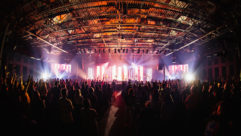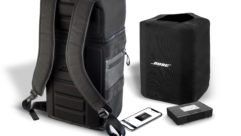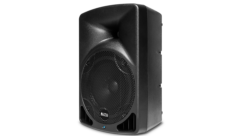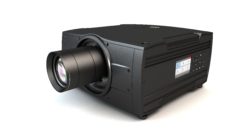
In this edition of the SVC Podcast, SVC Contributing Editor Bennett Liles talks with Brent Hayes of SVL Productions and Aaron Johnson of Johnson AV Engineering regarding their sound, lighting and video upgrade for the First Free Church in Rockford, Illinois. Brent and Aaron lead the way through the sound upgrade that included Danley speakers and Powersoft amplifiers to cover a very large sanctuary seating nearly 1800 people. They describe both the design concept and the steps taken in the installation of the new sound system.
Links of interest:
- SVL Productions: Sound, Video and Lighting in Cherry Valley, Ill.
- Johnson AV Engineering: Consulting, Engineering and DSP Programming
- Danley Sound Labs: Speakers, Amps/DSP, Danley Digital Tools, Danley ION
- Powersoft K-Series and Ottocanali Series amplifiers used for the house sound
- Yamaha CL5 mixing console chosen for the main house
Download Podcast Here:
https://s3.amazonaws.com/nb-svc/public/public/1_14_14-Hayes-Johnson_FFC-…
Editor’s note: For your convenience, this transcription of the podcast includes timestamps. If you are listening to the podcast and reading its accompanying transcription, you can use the timestamps to jump to any part of the audio podcast by simply dragging the slider on the podcast to the time indicated in the transcription.
The First Free Church in Rockford, Ill., had to have a sound system that could handle both traditional services and those with live, high-energy bands. They called Brent Hayes with SVL Productions and he brought in Aaron Johnson from Johnson AV Engineering to help with the design. They’re here to tell us about it, coming up next on the SVC Podcast.
SVC: Brent Hayes and Aaron Johnson, thanks for joining us on the SVC Podcast from the Chicago area. We’re talking about an installation at the First Free Church in Rockford that involved sound and lighting and projection. This is a pretty big church that seats about 1,800 people over a very wide area. Brent, they called you in from SVL Productions so tell us a little about your outfit there.
Brent: SVL, we’re a full-system integrator. We do have a rental side of our company, too, but on the system integration side, we do everything with churches and corporate ballrooms, corporate conference rooms, as well as commercials installations as well; everything from sound, video and lighting. [Timestamp: 1:29]
And you worked together with Aaron on this project. Aaron, what’s been happening at Johnson AV Engineering?
Aaron: We do design engineering for lots of contractors and production companies, and I’ve got quite a few different projects going on—an auditorium, lots of churches in the area, a couple of conference rooms as well. [Timestamp: 1:49]
Church AV projects can be pretty interesting because they can run from traditional services that require very little in the way of sound and video to live music and some very ambitious setups. At the First Free Church what do they have, high-energy live performance or more traditional?
Brent: It’s actually both. They have two services currently on the weekends. They have an earlier service, which is very traditional with the organ and choir and orchestra—a full orchestra. And then their second service is a very contemporary service with a full band; no choir, no organ. So they’re kind of right in the middle, I’d say. [Timestamp: 2:27]
It looks like a pretty big place and very spread out, a large area to cover. Brent, what was the main challenge with the sound upgrade?
Brent: Well, one of the things First Free has been known for in Rockford is that they do a lot of Christian events. They bring in a lot of Christian acts, and they actually have an outside amphitheater that in the past, every summer, four or five big acts have been in there. There’s a little time off with that now, while transitioning some of the acts in the main room as well as their sound system. It was dated and ready to take a step into the future with both the sound and they also wanted to refresh the room and give it kind of a full facelift, if you will. It’s all new carpet and chairs, painted the whole place. They did a little work to the backdrop and freshened that up a little bit, as well as some other things around the facilities. [Timestamp: 3:13]
Obviously with a lot of live music going on, a bad sound system is really going to be crusher from the beginning. I noticed that at the heart of this system you put in a Yamaha CL5 mixer. Was that your idea or did they specifically ask for that one?
Brent: When we did some demos, they looked at the cost versus functionality in the CL5 and they fell in love with it. We gave them a list of choices and they ultimately decided on that one. [Timestamp: 3:38]
Yeah, the CL5 is used by a lot of churches and it may be because it seems to have the perfect combination of virtual controls and real faders and knobs that you can wrap your fingers around.
Brent: Yeah, I agree. The Yamaha interface was very easy and intuitive to use for mixing tech staff and volunteers, and with the feature set they wanted. The CL5 had everything and the price was well below some of the other consoles we were looking at. It ended up being a really good fit. [Timestamp: 4:05]
In looking at a few pictures of the First Free Church, it looks like a very wide spread on the house. What have you got there, Aaron, close to a 180-degree wraparound there?
Aaron: Yeah, it about 160 degrees left wall to right wall, and it is pretty much a perfect circle on the back wall reaching all the way around. [Timestamp: 4:23]
And the stage looks pretty wide. How do they do the stage monitoring? Do they feed that out of an aux on the main house mixer or do they have a separate monitor mixer somewhere or have they got it set up for the performers to do their own monitors?
Brent: They have Avioms for the band, so they have the ability for some conventional wedges because there are times when they need them. But for the most part, everybody’s on in-ears. There are still a couple of hot spots for the orchestra, and some conventional wedges for the choir, some hidden side fills feed them, but other than that, they try to keep the stage volume down as low as possible. [Timestamp: 4:54]
That always seems like a big time saver for the bands and takes a huge load off of the main house sound people. The in-ears keep the stage nice and uncluttered, too.
Brent: They do sound check for both services before the first service, and then in between they do a full switch-over of the bands. They definitely need to save as much time as possible. [Timestamp: 5:12]
That’s got to be something they have to have worked out pretty much in detail, holding a traditional service and then completely shifting gears on the technical setup. I guess that would be to accommodate the older members and then bring mainly the younger people in for the live music worship style.
Brent: I believe you’re correct, yeah.
So you have the Danley speakers, which are passive, and you have the Powersoft amplifiers located somewhere else. Did you put those in an equipment room or a rack nearby?
Brent: The existing sound system had, where those power amps are, which was actually behind front of house.There was obviously some budget concerns when this all got going, and so we were trying to not necessarily reuse, but any place that we could have a cost savings that didn’t affect performance, we went that way. So keeping the amps there, using the Powersoft low power draw, and not having to rewire any circuits, which meant no money going to electricians, so we could put money back into gear and performance. [Timestamp: 6:07]
That looks like there could have been some serious cable runs. Was there a lot of running speaker cabling or did you use the existing system components for that?
Brent: We did replace the cabling to the speakers. The existing cabling was [in] the wrong locations, so we did replace that but we didn’t have to replace amp racks or a lot of power. We were able to reutilize everything they had. [Timestamp: 6:29]
One of the more serious and time-consuming things that can come up with these projects is electrical problems with the existing sound system. Did you run into any re-fits with that or were you able to just power up the new system and go with it?
Brent: We were able to plug it in and go.
Well I know that saved a lot of time and trouble. Chasing ground loops and stuff with an old electrical system can get almost spiritual in itself.
Brent: Yeah, absolutely.
Once you got it up and running and tweaked out, how long did it take to get their people up to speed on running it? Did you have to do any training or did they just pick it up and go?
Aaron: Yeah, it took us three-and-a-half days to commission, mainly because of the complexity of the setup that we used, which was an actual left-right stereo image for actually every seat in the sanctuary, which is difficult to do in a space that size and that shape. In order to do that, we ended up having to split it down into essentially three subsystems. There are technically three left-right pairs of loudspeakers covering the entire seating area, both with a far throw and a down fill array. That took quite a bit of time to get those things all aligned and set up properly. But as far as the acoustics of it, the arrays were, I mean, right off the bat, the Danley loudspeakers are great loudspeakers, so we didn’t really have to spend much time making the speakers themselves sound good. It’s just aligning it time-wise and doing a little bit of EQ to compensate for room reflections and that sort of thing. [Timestamp: 8:00]
I couldn’t really tell from the pictures. Is that place carpeted or is it all a hard floor?
Aaron: It’s carpeting.
Oh, well that makes a huge difference in the acoustics.
Aaron: Yeah, and there was room acoustics that were also treated as well. There was a lot of room acoustic treatment throughout the space, the back wall, the front of the balcony face, the soffit areas up in the ceiling, and the stage sidewalls and everything. Those were all newly treated. [Timestamp: 8:26]
The pictures make it look like a very high ceiling and a long acoustic throw from the main house speakers to the seats.
Aaron: I want to say it was like 60ft. or 70ft., I think, at the farthest spot.
Not all that much.
Aaron: No, which is kind of the big advantage. I mean I want to say since it is semicircular, it’s probably like 100ft. radius, 110ft., something like that, to a point, but the arrays are obviously built further out in the room than where the focal point would be. [Timestamp: 8:56]
Could be a wide angle lens just makes the place look much bigger. Was there anything else you did on the sound system?
Brent: I think the only other big thing on the sound system is that we did put in a cardioid subarray that Aaron designed, and that works pretty darn good, actually. [Timestamp: 9:10]
Big space to cover at the First Free Church and two very different styles of services to make sound right. Brent Hayes from SVL Productions and Aaron Johnson from Johnson AV Engineering. In part two we’ll get into the lighting and video. Thanks for being here to tell us how you made it all happen.










